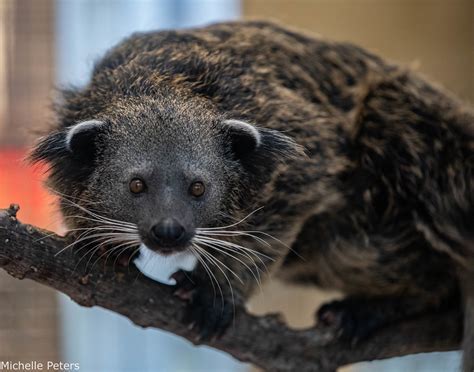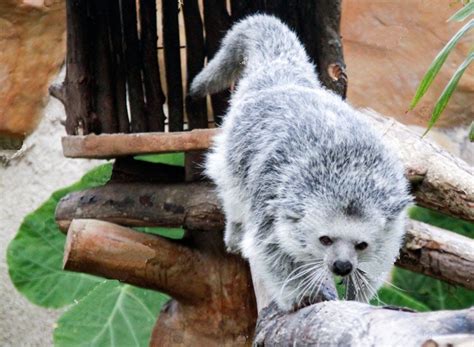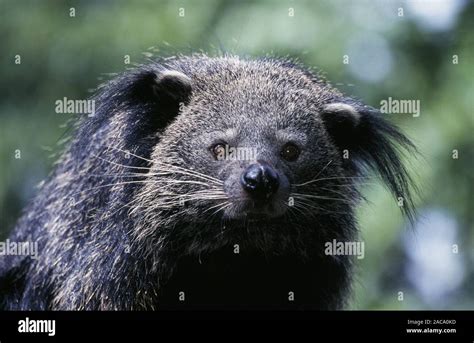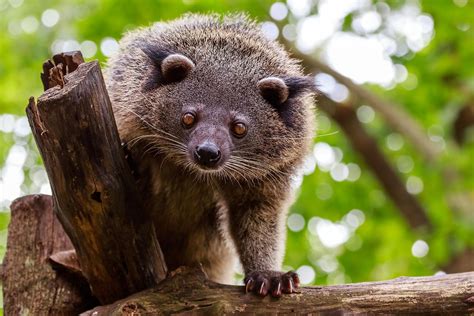What Is A Bearcat

The term "bearcat" is a colloquialism that has been used to describe several different animals, often causing confusion due to its non-scientific and variable application. Historically, the term has been associated with the binturong (Arctictis binturong), a species of mammal that belongs to the Viverridae family, which includes civets and genets. The binturong is native to Southeast Asia and is known for its distinctive appearance, which somewhat resembles a cross between a bear and a cat, hence the name "bearcat." However, it is essential to note that the binturong is neither a bear (Ursidae) nor a cat (Felidae) but rather a unique species within its own right.
In addition to its association with the binturong, the term "bearcat" has also been used in other contexts. For example, in sports, the University of Cincinnati's athletic teams are nicknamed the Cincinnati Bearcats. This usage is unrelated to the animal and is instead a reference to the school's early athletic teams, which were known for their tenacity and strength, qualities that might be metaphorically linked to both bears and cats.
Understanding the term "bearcat" requires an appreciation of its historical and contextual usage. In biological terms, when referring to the binturong, the bearcat is an animal that inhabits the forests of Southeast Asia, feeding on fruits, leaves, and small animals. It is known for its shaggy fur, long tail, and unique ability to climb trees. Conservation efforts are in place to protect the binturong and its habitats, as it faces threats from deforestation and hunting.
Key Points
- The term "bearcat" is primarily used to describe the binturong, a species of mammal in the Viverridae family.
- The binturong is native to Southeast Asia and is characterized by its bear-like and cat-like features, although it is neither a bear nor a cat.
- The term "bearcat" has also been adopted in other contexts, such as the nickname for the University of Cincinnati's athletic teams.
- Conservation efforts are necessary to protect the binturong and its habitats from threats like deforestation and hunting.
- Understanding the bearcat requires an appreciation of its biological characteristics, historical context, and varied usage of the term.
Biological Characteristics of the Binturong

The binturong, or bearcat, is a fascinating creature with several distinct biological characteristics. It is one of the largest species within the Viverridae family, with adults typically weighing between 60 to 90 kilograms (132 to 198 pounds) and measuring approximately 1.4 to 1.9 meters (4.6 to 6.2 feet) in length, including their tail. Their diet consists mainly of fruits, although they are also known to eat leaves, insects, and small animals, showcasing their adaptability and omnivorous nature.
Habitat and Distribution
The binturong is found in the tropical forests of Southeast Asia, including countries such as Indonesia, Malaysia, the Philippines, and Thailand. They are adept climbers and spend a significant amount of time in trees, where they forage for food and shelter. Their ability to adapt to different habitats, from primary forests to secondary forests and even plantations, is crucial for their survival, given the rapid deforestation and habitat fragmentation in their native regions.
| Characteristics | Description |
|---|---|
| Weight | 60 to 90 kilograms (132 to 198 pounds) |
| Length | 1.4 to 1.9 meters (4.6 to 6.2 feet), including tail |
| Diet | Fruits, leaves, insects, small animals |
| Habitat | Tropical forests of Southeast Asia |

Conservation Status and Threats

The binturong is listed as Vulnerable on the IUCN Red List, primarily due to the rapid decline in its population resulting from habitat loss and hunting. The destruction of their forest habitats for agriculture, urbanization, and logging significantly reduces the binturong’s available living space and access to food. Furthermore, they are hunted for their fur and body parts, which are used in traditional medicine. Efforts to protect the binturong and its habitat are underway, including the establishment of protected areas and education programs aimed at reducing hunting and promoting coexistence with humans.
Conservation Efforts
Several organizations and governments are working together to conserve the binturong and its habitat. This includes initiatives to monitor their population, protect their habitats, and engage local communities in conservation efforts. Education plays a critical role in changing attitudes towards the binturong and promoting its conservation. By understanding the importance of the binturong in its ecosystem and the challenges it faces, we can work towards a future where this unique species thrives.
In conclusion, the bearcat, or binturong, is a fascinating and unique species that faces significant challenges in the modern world. Through conservation efforts, education, and a commitment to protecting its habitat, we can ensure the long-term survival of this remarkable animal. Its story serves as a reminder of the importance of biodiversity and the need for concerted action to protect our planet's precious wildlife.
What is the primary threat to the binturong’s survival?
+The primary threats to the binturong’s survival are habitat loss and fragmentation due to deforestation, as well as hunting for its fur and body parts used in traditional medicine.
What can be done to help conserve the binturong?
+Conservation efforts include protecting and restoring its natural habitats, educating local communities about the importance of preserving biodiversity, and supporting organizations that work to monitor and protect binturong populations.
Why is the binturong important to its ecosystem?
+The binturong plays a crucial role in its ecosystem as a seed disperser and predator, helping to maintain the balance of the forest ecosystem. Its loss could have significant cascading effects on the biodiversity of the region.



